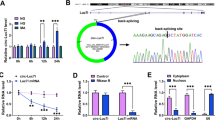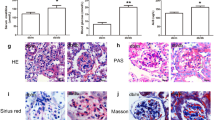Abstract
Abnormal proliferation of human mesangial cells was the earliest pathological character in chronic kidney disease and linked to the accumulation of extracellular matrix and glomerular sclerosis. Multifunctional Angiotensin (AngII) had been emerged as a key player in initiation and progression of fibrogenic processes in kidney. In mesangial cells, treatment with the proliferation stimulus AngII triggered the escalated cyclinD1 expression, where its association with HuR increased dramatically. In our study, it was demonstrated that both in vivo and in vitro HuR redistribution in dysregulated mesangial cell proliferation accompanied by an abundant cyclinD1 expression following the AngII treatment. ActinomycinD experiments revealed that AngII stabilized cyclinD1 mRNA in human mesangial cells via HuR. Furthermore, employing the RIP-Chip assay yielded cyclinD1 mRNA with a higher affinity to HuR in mesangial cells induced by AngII compared with the normal ones in vitro study. Analysis of a cyclinD1 mRNA directly implicated HuR in regulating cyclinD1 production: cyclinD1 translation increased in HuR-shuttling cells induced by AngII and declined in cells in which HuR levels were lowered by RNA interference. We proposed that the release of HuR-bound mRNAs via an AngII–cyclinD1–HuR regulatory axis was implicated in the evolution of proliferative kidney diseases, providing us a novel therapeutic strategy to treat glomerular disease.






Similar content being viewed by others
References
Schlöndorff D, Banas B (2009) The mesangial cell revisited: no cell is an island. J Am Soc Nephrol 20:1179–1187
Abboud H (2012) Mesangial cell biology. Exp Cell Res 318:979–985
Rüster C, Wolf G (2006) Renin–angiotensin–aldosterone system and progression of renal disease. J Am Soc Nephrol 17:2985–2991
Turner J, Bauer C, Abramowitz M, Melamed M, Hostetter T (2012) Treatment of chronic kidney disease. Kidney Int 81:351–362
Boffa J, Lu Y, Placier S, Stefanski A, Dussaule J et al (2003) Regression of renal vascular and glomerular fibrosis: role of angiotensin II receptor antagonism and matrix metalloproteinases. J Am Soc Nephrol 14:1132–1144
Wolf G, Wenzel U (2004) Angiotensin II and cell cycle regulation. Hypertension 43:693–698
Watanabe G, Lee R, Albanese C, Rainey W, Batlle D et al (1996) Angiotensin II activation of cyclin D1-dependent kinase activity. J Biol Chem 271:22570–22577
Lang S, Hartner A, Sterzel R, Schöcklmann H (2000) Requirement of cyclin D1 in mesangial cell mitogenesis. J Am Soc Nephrol 11:1398–1408
Hong Q, Li C, Xie Y, Lv Y, Liu X et al (2012) Kruppel-like factor-15 inhibits the proliferation of mesangial cells. Cell Physiol Biochem 29:893–904
Keene J (2007) RNA regulons: coordination of post-transcriptional events. Nat Rev Genet 8:533–543
Anderson P (2008) Post-transcriptional control of cytokine production. Nat Immunol 9:353–359
Abdelmohsen K, Gorospe M (2010) Posttranscriptional regulation of cancer traits by HuR. Wiley Interdiscip Rev RNA 1:214–229
Masuda K, Abdelmohsen K, Kim M et al (2011) Global dissociation of HuR–mRNA complexes promotes cell survival after ionizing radiation. EMBO J 30:1040–1053
Mazan-Mamczarz K, Hagner P, Corl S et al (2008) Post-transcriptional gene regulation by HuR promotes a more tumorigenic phenotype. Global changes in HuR-bound mRNAs and tumor progression. Oncogene 27:6151–6163
Nowotarski S, Shantz L (2010) Cytoplasmic accumulation of the RNA-binding protein HuR stabilizes the ornithine decarboxylase transcript in a murine nonmelanoma skin cancer model. J Biol Chem 285:31885–31894
Woo H, Zhou Y, Yi X et al (2009) Regulation of non-AU-rich element containing c-fms proto-oncogene expression by HuR in breast cancer. Oncogene 28:1176–1186
Erkinheimo T, Lassus H, Sivula A et al (2003) Cytoplasmic HuR expression correlates with poor outcome and with cyclooxygenase 2 expression in serous ovarian carcinoma. Cancer Res 63:7591–7594
Lal A, Mazan-Mamczarz K, Kawai T, Yang X, Martindale J et al (2004) Concurrent versus individual binding of HuR and AUF1 to common labile target mRNAs. EMBO J 23:3092–3102
Doller A, Schlepckow K, Schwalbe H, Pfeilschifter J, Eberhardt W (2010) Tandem phosphorylation of serines 221 and 318 by protein kinase Cδ coordinates mRNA binding and nucleocytoplasmic shuttling of HuR. Mol Cell Biol 30:1397–1410
Huwiler A, Akool S, Aschrafi A, Hamada F, Pfeilschifter J et al (2003) ATP potentiates interleukin-1 beta-induced MMP-9 expression in mesangial cells via recruitment of the ELAV protein HuR. J Biol Chem 278:51758–51769
Doller A, Gauer S, Sobkowiak E, Geiger H, Pfeilschifter J et al (2009) Angiotensin II induces renal plasminogen activator inhibitor-1 and cyclooxygenase-2 expression post-transcriptionally via activation of the mRNA-stabilizing factor human-antigen R. Am J Pathol 174:1252–1263
Akhtar J, Wang Z, Zhang ZP, Bi MM (2013) Lentiviral-mediated RNA interference targeting stathmin1 gene in human gastric cancer cells inhibits proliferation in vitro and tumor growth in vivo. J Transl Med 11:212
Zhang P, Cao M, Liu Y, Lv Z, Yang Q et al (2012) PDGF-induced airway smooth muscle proliferation is associated with human antigen R activation and could be weakened by AMPK activation. Mol Biol Rep 39:5819–5829
Ma W, Cheng S, Campbell C, Wright A, Furneaux H (1996) Cloning and characterization of HuR, a ubiquitously expressed Elav-like protein. J Biol Chem 271:8144–8151
Khabar K (2005) The AU-rich transcriptome: more than interferons and cytokines, and its role in disease. J Interferon Cytokine Res 25:1–10
Cok S, Acton S, Morrison A (2003) The proximal region of the 3′-untranslated region of cyclooxygenase-2 is recognized by a multimeric protein complex containing HuR, TIA-1, TIAR, and the heterogeneous nuclear ribonucleoprotein U. J Biol Chem 278:36157–36162
Doller A, Huwiler A, Müller R, Radeke H, Pfeilschifter J et al (2007) Protein kinase C alpha-dependent phosphorylation of the mRNA-stabilizing factor HuR: implications for posttranscriptional regulation of cyclooxygenase-2. Mol Biol Cell 18:2137–2148
Breving K, Esquela-Kerscher A (2010) The complexities of microRNA regulation: mirandering around the rules. Int J Biochem Cell Biol 42:1316–1329
Moore M (2005) From birth to death: the complex lives of eukaryotic mRNAs. Science 309:1514–1518
Qian Y, Feldman E, Pennathur S et al (2008) From fibrosis to sclerosis: mechanisms of glomerulosclerosis in diabetic nephropathy. Diabetes 57:1439–1445
Jefferson J, Shankland S, Pichler R (2008) Proteinuria in diabetic kidney disease: a mechanistic viewpoint. Kidney Int 74:22–36
Navarro-González J, Mora-Fernández C, Fuentes MMd, García-Pérez J (2011) Inflammatory molecules and pathways in the pathogenesis of diabetic nephropathy. Nat Rev Nephrol 7:327–340
Acknowledgments
All authors contributed to the scientific conduct of the study, data review and analysis, and manuscript preparation and review. Financial supported by the National Natural Science Foundation of China (Grant 30971381) and Shandong Natural Science Foundation (ZR2009CM043).
Author information
Authors and Affiliations
Corresponding authors
Additional information
Yu Che and Liu Yi contributed equally to this research.
Rights and permissions
About this article
Cite this article
Che, Y., Yi, L., Akhtar, J. et al. AngiotensinII induces HuR shuttling by post-transcriptional regulated CyclinD1 in human mesangial cells. Mol Biol Rep 41, 1141–1150 (2014). https://doi.org/10.1007/s11033-013-2960-1
Received:
Accepted:
Published:
Issue Date:
DOI: https://doi.org/10.1007/s11033-013-2960-1




